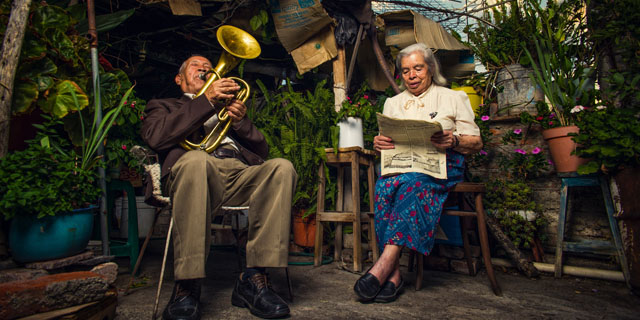Editorial: Alternative accommodation models in later life
Understanding the options

[Image: Cristian Newman]
Over the past five years or more I have been privy to many discussions about alternative living models for later life. Participants in their 50s, 60s and 70s planning for the future, could not imagine themselves living in any of the mainstream retirement living or aged-care models currently on offer and were wondering what other options there were, so I decided to investigate. There are a number of alternative accommodation models for seniors and these include:
1. Home-sharing is a concept with multiple variations. Homeshare Australia for example, matches people who want companionship and practical help around the house with people who need accommodation. There are other models but essentially, sharing a home has the benefits of shared expenses, companionship and increased sense of security. See Homeshare article in this issue. www.homeshare.org.au
2.Co-housing is a model wherein members buy a private residence in an intentional community and share common spaces. The concept originated in Denmark in the 1970s and goes some way to addressing such issues as affordability, environmental impact and community building. Many of these projects are multigenerational. A variation on this theme is the Henry Project, which connects people, helping them find suitable affordable housing through co-ownership. Cohousing Australia: www.communities.org.au The Henry Project: www.henryproject.com
3. Niche Communities. In this model, people of retirement age with shared common interests or lifestyles congregate to form a community. Being amongst like-minded people facilitates friendships and a sense of belonging. Some examples are LGBTI, culture specific, lifelong learning and arts colonies. This model is popular in the United States. https://www.northwesternmutual.com/financial-guidance/insights-and-ideas/articles/2016/10/are-niche-retirement-communities-the-future-for-retirees
4. Multigenerational Living. There are a number of advantages to multigenerational living including shared costs, babysitting and eldercare. One developer in the US, the Lennar Corporation launched its NextGen model in 2011, which incorporates two homes in one. The homes are attached with doors providing options for shared space or privacy according to the requirements of the owners. The beauty of this model is that if the generations of one family don’t choose to live together, the ‘other’ home can be rented out. See article in this issue. https://www.domain.com.au/news/how-the-rise-of-multigenerational-living-is-changing-the-way-we-build-housing-20170428-gvv1rh/
5. The Village Model. This is a consumer driven, grassroots approach wherein villages are formed around neighbourhoods with the aim of assisting older people to age in place. There is an annual fee, which is generally quite low and affords access to support services provided by volunteers or other members, and referrals to existing community services. These include such non-professional services as handyman, housekeeper, dog walker and transport. Village members are generally very involved in the organisation and running of the village, which also offers its members ample opportunity to socialise. Beacon Hill Village in the US, developed in 2001 is one example. https://academic.oup.com/gerontologist/article/52/3/418/580328/The-Village-Model-A-Consumer-Driven-Approach-for/
6. Cruise Retirement. This is a relatively new model in which retirement communities of like-minded people travelling the world on cruise ships, or retirees take back-to-back cruises. Bulk buying enables cruise companies to offer an affordable alternative to traditional retirement village living. There are medical, health and wellness facilities on each ship and plenty of opportunities to socialise and meet new people. See article in this issue. http://www.afr.com/business/tourism/grey-cruising-is-making-people--and-cruise-lines--rethink-retirement-living-20170323-gv4zao
While looking into alternative accommodation, I came across a Senior Living Blog from 2013, providing eight predictions about the changing senior and assisted living options in response to socio-economic conditions:
- The decline of the nursing home model of care
- The rise of technology-enhanced senior care
- More multigenerational housing options
- Neighbourhood-friendly civic planning
- Cooperative living: senior co-housing
- More amenities and lifestyle perks in traditional senior housing
- Going green: eco-friendly senior living
- Ageing in place means a booming home healthcare industry
http://www.aplaceformom.com/blog/2013-8-27-future-senior-care/
For more information on many of the above accommodation models: https://www.caring.com/articles/creative-senior-housing-options
_______________________________________________________________________________________________________
Master of Ageing subjects due to run in Term 3 beginning on the 10th July are:
- Body of Ageing https://handbook.unimelb.edu.au/2017/subjects/poph90257
- Leadership for an Ageing Workforce https://handbook.unimelb.edu.au/2017/subjects/poph90266
- End of Life Issues https://handbook.unimelb.edu.au/2017/subjects/poph90259
And for those who’d like to find out more about ageing but are time poor, we are running our MOOC ‘Rethinking Ageing, are we prepared to live longer?’ on August 7th, September 25th and November 13th https://www.coursera.org/learn/ageing See article in this issue.
Many thanks to all of our contributors to this issue, and if you have any items to for the next issue, which will come out in September/October, please contact Ruth Williams: ruth.williams@unimelb.edu.au
[Source: Lena Gan, Director Ageing Programs, Melbourne School of Population and Global Health, The University of Melbourne]